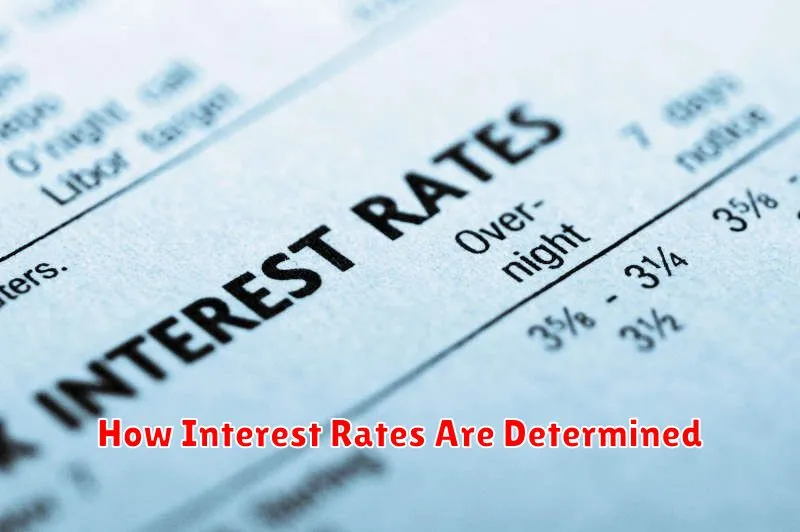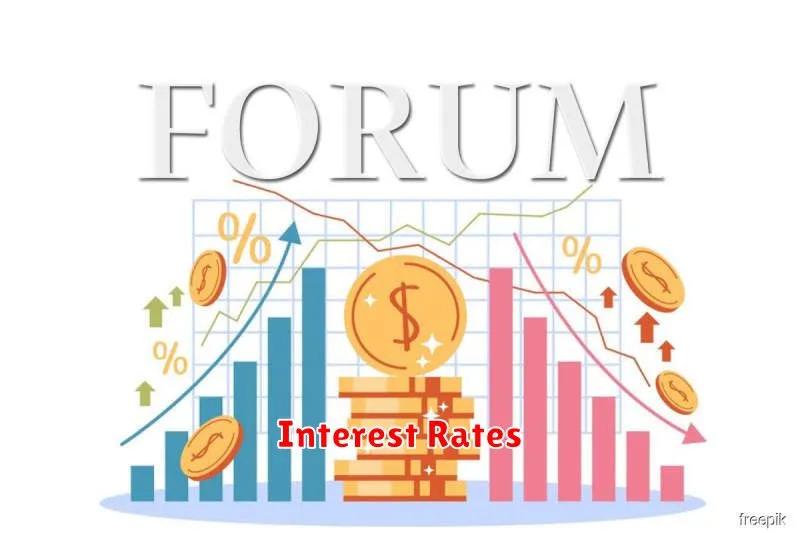Interest rates play a crucial role in the cost of borrowing money, directly impacting the affordability of your loans. Whether you’re eyeing a mortgage, juggling credit card debt, or considering a business loan, understanding how interest rates fluctuate and affect your monthly payments is vital for making informed financial decisions.
This comprehensive guide delves into the intricacies of interest rate fluctuations and their implications on your borrowing. We’ll explore the factors that influence rate changes, the different types of interest rates (fixed vs. variable), and provide practical tips on how to navigate the lending landscape effectively to secure the most favorable terms for your financial situation.
How Interest Rates Are Determined

Interest rates are influenced by a complex interplay of factors, but the most fundamental are the principles of supply and demand, along with central bank policies.
Supply and Demand: Like any good or service, the price of money (interest rates) fluctuates based on how much money is available to lend (supply) and how many people or businesses want to borrow (demand). High demand and limited supply generally push interest rates up, while low demand and abundant supply tend to lower them.
Central Bank Policies: Central banks, such as the Federal Reserve in the United States, play a crucial role in setting benchmark interest rates. They adjust these rates to influence economic activity, aiming to control inflation and support stable growth. When central banks lower rates, borrowing becomes cheaper, stimulating spending and investment. Conversely, raising rates makes borrowing more expensive, potentially slowing down the economy to curb inflation.
Other Factors: In addition to supply, demand, and central bank actions, other factors that can affect interest rate levels include:
- Inflation: Lenders raise rates to maintain the value of their returns when inflation erodes purchasing power.
- Economic Growth: Strong economic growth often leads to higher demand for credit, potentially driving up rates.
- Government Policy: Government borrowing and spending can influence overall demand for funds and impact rates.
- Global Events: International economic conditions, geopolitical events, and global capital flows can all exert pressure on interest rates.
The Relationship Between Interest Rates and Loan Costs
Interest rates are a fundamental factor influencing the overall cost of borrowing money. When you take out a loan, whether it’s for a home, a car, or personal expenses, the interest rate determines how much you’ll pay back on top of the principal amount borrowed.
Simply put, interest rates represent the cost of borrowing money. Lenders charge interest as compensation for providing you with the funds. The interest rate is typically expressed as a percentage of the loan amount.
Here’s how the relationship works:
- Higher interest rates equate to higher loan costs. A larger portion of your monthly payments will go towards interest payments, increasing the total amount repaid over the life of the loan.
- Lower interest rates result in lower loan costs. With a lower rate, you’ll pay less in interest charges, making the loan more affordable and reducing the overall expense.
Understanding the direct link between interest rates and loan costs is crucial when comparing loan offers, planning your finances, and making informed borrowing decisions.
How to Get the Best Interest Rate on Your Loan
Securing a low interest rate on a loan can save you thousands of dollars over the loan’s lifespan. Here’s how to improve your chances of getting the best possible rate:
1. Improve Your Credit Score: Your credit score is a major factor lenders use to assess your creditworthiness. A higher score demonstrates responsible financial behavior and can lead to lower interest rate offers. Check your credit report for errors, pay down existing debt, and avoid opening new credit accounts before applying for a loan.
2. Shop Around and Compare Offers: Don’t settle for the first loan offer you receive. Get quotes from multiple lenders, including banks, credit unions, and online lenders. Pay close attention to the Annual Percentage Rate (APR), which reflects the total cost of borrowing, including interest and fees.
3. Consider a Shorter Loan Term: While shorter loan terms often come with higher monthly payments, they generally have lower interest rates. If your budget allows, opting for a shorter term can save you money on interest over time.
4. Make a Larger Down Payment: When you make a larger down payment, you borrow less money overall, which can result in a lower interest rate. Lenders perceive less risk when you have more equity in the asset you’re financing.
5. Negotiate with Lenders: Don’t be afraid to negotiate with lenders for a better interest rate. If you have a strong credit history or have received a competing offer, leverage that information to your advantage.
6. Explore Rate Discount Opportunities: Some lenders offer interest rate discounts for things like setting up automatic payments or having an existing relationship with the institution. Be sure to inquire about any potential discounts.
Fixed vs. Variable Interest Rates: What’s the Difference?
When you’re considering taking out a loan, one of the most important factors to understand is the interest rate. The interest rate determines how much you’ll pay back on top of the principal loan amount. Interest rates can be either fixed or variable, and each type has its own advantages and disadvantages.
With a fixed interest rate, the interest rate remains the same for the entire term of the loan. This means your monthly payments will also stay the same, which can make budgeting easier. Fixed rates are generally higher than variable rates at the outset, but offer stability and predictability.
In contrast, a variable interest rate can fluctuate over the life of the loan. Variable rates are typically tied to a benchmark rate, such as the prime rate. When the benchmark rate goes up, so does your interest rate, and vice versa. Variable rates generally start lower than fixed rates, but carry the risk of potential increases in the future.
Ultimately, the best type of interest rate for you depends on your individual circumstances and risk tolerance. If you value predictability and want to lock in a rate for the long term, a fixed interest rate may be a good option. However, if you’re comfortable with some level of uncertainty and are willing to gamble on the possibility of lower rates, a variable interest rate could potentially save you money.
How Interest Rates Affect Your Mortgage Payments

Interest rates are a primary factor influencing your monthly mortgage payments. When interest rates rise, so do your payments (for adjustable-rate mortgages or when refinancing), and when they fall, your payments may decrease. This correlation exists because interest is the cost of borrowing money.
Here’s a simple breakdown:
- Higher interest rates mean you’ll pay more interest over the life of your loan, increasing your monthly payments.
- Lower interest rates result in less overall interest paid, potentially reducing your monthly payments.
Understanding this relationship is crucial, especially with adjustable-rate mortgages (ARMs) where rates fluctuate. If you have a fixed-rate mortgage, your payments remain stable, providing predictability even amidst market changes.
Strategies to Manage High-Interest Loans
High-interest loans can place a significant strain on your finances, accruing interest quickly and potentially trapping you in a cycle of debt. However, there are strategies you can implement to regain control and minimize the impact of these loans.
Prioritize Repayment: Allocate as much money as you can reasonably afford towards paying down your high-interest loans first. Even small extra payments can make a difference in the long run by reducing the principal balance and the amount of interest accrued.
Explore Debt Consolidation: Consider consolidating your high-interest debts into a single loan with a lower interest rate. This can simplify your payments and potentially save you money on interest charges over the life of the loan.
Negotiate with Lenders: Don’t hesitate to contact your lenders and try to negotiate lower interest rates or more favorable repayment terms. Explain your financial situation honestly and propose a plan that works for you. The worst they can do is say no.
Seek Financial Counseling: If you’re struggling to manage your high-interest loans, consider seeking guidance from a reputable financial counselor. They can help you assess your options, develop a budget, and negotiate with creditors on your behalf.
Remember, managing high-interest loans effectively requires a proactive and informed approach. By understanding your options and taking steps to reduce your debt burden, you can regain control of your finances and work towards a more secure financial future.
How to Refinance Your Loan for a Better Interest Rate
Refinancing your loan can be a smart move to save money on interest payments and potentially pay off your loan faster. Here’s how to do it:
1. Check Your Credit Score: Your credit score plays a crucial role in determining the interest rate you qualify for. A higher credit score will generally result in lower interest rate offers. Obtain a free copy of your credit report and review it for any errors or areas for improvement.
2. Research Lenders and Compare Rates: Shop around and compare interest rates and loan terms from different lenders, including banks, credit unions, and online lenders. Consider factors such as interest rates, fees, and loan terms (e.g., loan duration).
3. Gather Necessary Documentation: Be prepared to provide lenders with documentation such as proof of income, employment history, and current loan information. Having these documents ready can expedite the refinancing process.
4. Apply for Pre-Approval: Get pre-approved by multiple lenders to compare their offers without impacting your credit score. Pre-approval gives you an idea of the interest rates you qualify for and can strengthen your negotiating position.
5. Choose the Best Offer and Finalize: Evaluate the offers you receive, considering the interest rate, loan terms, and fees. Once you’ve selected the best option, carefully review the loan agreement and finalize the refinancing process with your chosen lender.
Refinancing can be beneficial, but it’s essential to weigh the costs and benefits. Consider factors like closing costs, potential savings, and your long-term financial goals before making a decision.

